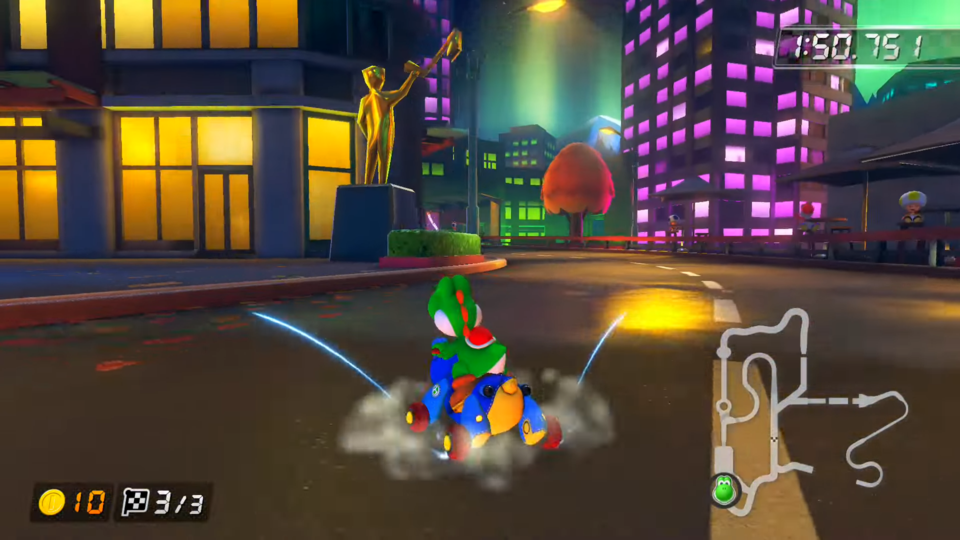The city of Â鶹´«Ã½Ó³»was immortalized in Nintendo’s Super Mario universe when a track based on the city was added to the mobile game Mario Kart Tour.
Now, the Â鶹´«Ã½Ó³»Velocity track has been added to the flagship Mario Kart game on the Nintendo Switch, Mario Kart 8. The track plays fast and loose with the geography and landmarks of Â鶹´«Ã½Ó³»but includes some nifty details that Â鶹´«Ã½Ó³»residents will recognize, including two trips across the ice at the home of the Canucks, Rogers Arena — called “M Arena” in the game.
One of the most specific of those Â鶹´«Ã½Ó³»references is found right outside Rogers Arena, both in the game and in real life. Just as a driver exits Rogers Arena during the third and final lap, they’ll pass a golden statue in the likeness of the real-life statue of former Canucks head coach Roger Neilson hoisting a white towel on the end of a hockey stick.
It’s a detail that doesn’t exist in the Mario Kart Tour version of the Â鶹´«Ã½Ó³»Velocity track, so it was added just for the Switch version.
Roger Neilson and Mario exist in the same universe
Let’s just take a moment to ruminate on the implications of this.
We already knew that hockey existed in the Mario universe — Mario and his Nintendo friends, as well as Sonic the Hedgehog and his Sega friends, play hockey together in the Mario & Sonic at the Olympic Winter Games series — but this gets a lot more specific.
Let’s start with the statue, which was , cast in bronze in Langley, and installed outside of Rogers Arena in April of 2011 — all of which must also have happened in the Mario universe. The statue depicts Neilson symbolically raising the white flag in mock surrender to the officials after some questionable officiating in Game 2 of the Canucks’ playoff series against the Chicago Blackhawks.
The statue’s existence in Mario Kart implies that Neilson exists in the same universe as , his brother, Luigi Mario, and all of the bizarre creatures that appear in the Mario games, from Bowser to to all the various Koopalings.
Somewhere, while Mario is jumping on the heads of Koopa Troopas and sending their carapaces spinning violently into their brethren, Roger Neilson is clipping video of him doing so in order to break down how he can more efficiently bust up Bowser’s operations.
Neilson was an innovator, who was nicknamed “Captain Video” for his first forays into using video to illustrate his points to players, which soon became commonplace around the league. He also was one of the first coaches to track his own analytics in his time with the Toronto Maple Leafs, keeping tabs on scoring chances and other statistics and using those to influence who he sent out for specific faceoffs and line matching.
“All that had to start somewhere,” . “We were all packed in a little room under the stands at the Gardens when he showed us those first videos, on a basic TV, going over power play and penalty killing.
“It was new, but refreshing and I was all for it. Roger also introduced us to proper off-ice conditioning, got us working on faceoff plays and he probably came up with the first [defined chart] of scoring chances. Mostly, he made you accountable, to be prepared for every night like it was Game 7 of the Stanley Cup final.”
Neilson only made it to the Stanley Cup Final once as a coach and it was with the Canucks, featuring that immortalized-in-bronze moment when he raised the white flag. That led to the beginning of Towel Power, as Canucks fans seized on Neilson’s defiant moment and rallied around it, swinging white towels over their heads for the rest of the playoffs.
It’s a tradition that continues today, albeit only in spirit, as Canucks fans haven’t actually had the opportunity to swing towels at a Canucks home playoff game for eight years.
Teasing out the implications
Here’s the thing: it’s not just that Neilson exists in the Mario universe but that the specific moment of him raising the white flag exists in the Mario universe. This means that the Â鶹´«Ã½Ó³»Canucks exist in the same universe as Yoshi and Waluigi and that in the history of the Mario universe, the Canucks went on the same playoff run in the 1982 playoffs.
That means all the events that led up to Neilson raising the white towel also exist.
For instance, Neilson wasn’t even supposed to be head coach of the Canucks in those playoffs. He was an assistant coach and only took over behind the bench when Harry Neale was suspended ten games for fighting with fans during a game against the Quebec Nordiques. When the Canucks immediately went on a winning streak under Neilson, he remained as head coach for the playoffs.
So, in the Mario universe, Harry Neale also punched a Nordiques fan who was reaching around the glass to poke at Dave “Tiger” Williams.
Here’s the big question, though: did the Canucks win the 1982 Stanley Cup in the Mario universe?
The Mario universe must be an alternate dimension. After all, in the Mario universe you can drive underneath the Olympic cauldron in Vancouver, whereas in real life there’s a fountain that would block your path.
In the Mario universe, the denizens of Â鶹´«Ã½Ó³»obviously honoured Neilson with a statue the same way they did in this universe. This implies that all of the same events that led up to the moment of Neilson raising the white towel remained the same in both universes and that it had a similar impact on Â鶹´«Ã½Ó³»fans.
But that doesn’t say anything about what came after.
Perhaps in the Mario universe, a rogue blue shell came out of nowhere to crash into the front-running New York Islanders during the 1982 Stanley Cup Final, allowing the Canucks to catch up despite trailing behind the Islanders the entire season.
You never know.




